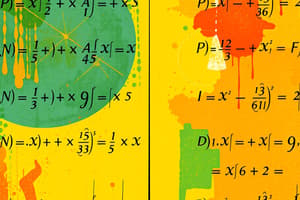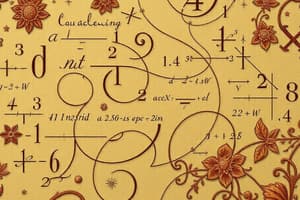Podcast
Questions and Answers
What are the values of u that satisfy the equation (3u − 1)(2u + 1) = 0?
What are the values of u that satisfy the equation (3u − 1)(2u + 1) = 0?
- u = 1/3 and u = -1/2 (correct)
- u = 2/3 and u = -1
- u = 1/2 and u = -1/3
- u = 1 and u = 0
Which of the following represents a function?
Which of the following represents a function?
- A relation where any x-value maps to one unique y-value (correct)
- A relation with no defined outputs for any x-value
- A relation where multiple x-values can map to the same y-value
- A relation where one x-value gives two different y-values
Which graphical representation does NOT demonstrate a function?
Which graphical representation does NOT demonstrate a function?
- A discrete set of points
- A vertical line (correct)
- A straight line with a slope
- A parabola opening upwards
What is true about the outputs of a function?
What is true about the outputs of a function?
In the context of functions, which statement is correct?
In the context of functions, which statement is correct?
If a relation gives one x-value input that produces two y-value outputs, how is this classified?
If a relation gives one x-value input that produces two y-value outputs, how is this classified?
Which of the following examples depicts a quadratic equation?
Which of the following examples depicts a quadratic equation?
How does one determine if a graph represents a function using the vertical line test?
How does one determine if a graph represents a function using the vertical line test?
What condition must be met for a function to be classified as One to One?
What condition must be met for a function to be classified as One to One?
Which of the following best describes the range of a function?
Which of the following best describes the range of a function?
In the equation $y = p(x − q)^2 + r$, what does the parameter 'r' represent?
In the equation $y = p(x − q)^2 + r$, what does the parameter 'r' represent?
What does the vertical line test determine about a function?
What does the vertical line test determine about a function?
If a quadratic function has an equation $y = p(x − q)^2 + r$ with $p < 0$, what is true about its vertex?
If a quadratic function has an equation $y = p(x − q)^2 + r$ with $p < 0$, what is true about its vertex?
What defines the possible inputs (x-values) for a function?
What defines the possible inputs (x-values) for a function?
How is the range of the quadratic function determined?
How is the range of the quadratic function determined?
What is the implication of $4 < x < 10$ for a function?
What is the implication of $4 < x < 10$ for a function?
What determines the range of a function as described?
What determines the range of a function as described?
In the example function f(x) = $
rac{2}{3(3x - 1)} + 2$, what is the best way to find its range?
In the example function f(x) = $ rac{2}{3(3x - 1)} + 2$, what is the best way to find its range?
For the function f(x) = ax + b, what must be true about the domain to ensure the function remains positive?
For the function f(x) = ax + b, what must be true about the domain to ensure the function remains positive?
What characteristic of vertical lines can be used to determine if a relation is a function?
What characteristic of vertical lines can be used to determine if a relation is a function?
For which of the following values of b would the function f(x) = ax + b be guaranteed to always remain positive?
For which of the following values of b would the function f(x) = ax + b be guaranteed to always remain positive?
What does the term 'approaching a specific value a' from above or below imply about the function's behavior?
What does the term 'approaching a specific value a' from above or below imply about the function's behavior?
If a function approaches a value a from below, what inequality describes its range?
If a function approaches a value a from below, what inequality describes its range?
What is a necessary condition for a quadratic function to be treated as a function in regards to its vertical line test?
What is a necessary condition for a quadratic function to be treated as a function in regards to its vertical line test?
Flashcards
Finding Range of a Function
Finding Range of a Function
Determining possible output values (y-values) of a function for all valid input values (x-values).
Large x-value Test
Large x-value Test
Substituting a very large value for x into the function to determine the function's behavior and estimate the range.
Function Behavior
Function Behavior
Describing how a function's output (y-value) changes as the input (x-value) changes
Range Inequality
Range Inequality
Signup and view all the flashcards
Domain Restriction
Domain Restriction
Signup and view all the flashcards
Finding the Range of f(x)
Finding the Range of f(x)
Signup and view all the flashcards
Square Root Function
Square Root Function
Signup and view all the flashcards
Domain of a Function
Domain of a Function
Signup and view all the flashcards
Function Definition
Function Definition
Signup and view all the flashcards
Not a Function
Not a Function
Signup and view all the flashcards
Function Notation
Function Notation
Signup and view all the flashcards
One-to-Many Relation
One-to-Many Relation
Signup and view all the flashcards
x-values
x-values
Signup and view all the flashcards
y-values
y-values
Signup and view all the flashcards
Graphical Relation
Graphical Relation
Signup and view all the flashcards
Solving for 'u'
Solving for 'u'
Signup and view all the flashcards
What is Domain?
What is Domain?
Signup and view all the flashcards
Relation
Relation
Signup and view all the flashcards
How to find the Domain?
How to find the Domain?
Signup and view all the flashcards
Many-to-One Relation
Many-to-One Relation
Signup and view all the flashcards
What's a Range?
What's a Range?
Signup and view all the flashcards
How to Find the Range?
How to Find the Range?
Signup and view all the flashcards
Vertex's Role in Range
Vertex's Role in Range
Signup and view all the flashcards
Study Notes
CAIE AS Level Mathematics Summary Notes
- The notes are updated for the 2023-2025 syllabus.
- The notes are summarized from theory syllabus.
- The notes are for personal use only.
Quadratics
- Quadratic Formula: Used to find solutions (zeros) to quadratic equations of the form ax² + bx + c = 0. Formula: x = (-b ± √(b² - 4ac)) / 2a
- Completing the Square: A method to rewrite a quadratic in the form p(x + q)² + r. Useful for various applications.
- Factorisation: Expressing a polynomial as the product of simpler terms (e.g., x² - 2x + 2 = (x − 1)(x − 2)). Two common methods are splitting the middle term or using a calculator.
- Solving Quadratic Equations by Completing the Square: A technique to solve quadratic equations by transforming them into the form p(x - q)² + r = 0, to isolate x.
- Quadratic Inequalities: Solving inequalities involving quadratic equations. Involves factoring the inequality, sketching the quadratic, identifying intersections with the x-axis, and determining the region satisfying the inequality (e.g., y ≤ 0 or y ≥ 0), considering if the points of intersection must be included.
- Discriminant: The value (b² - 4ac) helps determine the nature of the roots of a quadratic equation (number of intersections with the x-axis): -Positive discriminant: Two distinct real roots (two intersections) -Zero discriminant: Two equal real roots (one intersection) -Negative discriminant: No real roots (no intersection)
Finding the Coordinates of the Vertex
- The vertex is the highest or lowest point on a quadratic curve.
- Formula for the x-coordinate of the vertex: x = -b / 2a
Simultaneous Equations
- A set of equations with unknown variables that satisfy a condition.
- Techniques include elimination and substitution.
- Elimination: Requires multiplying equations such that variables have the same coefficient to cancel and solve for one variable.
- Substitution: Make an unknown variable the subject of the equation and substitute that expression into the other equation to solve.
- Simultaneous equations may include quadratics and lines, requiring solving a quadratic equation which results in the points of intersection.
Types of Functions and Relations
- Functions: A relationship between x-values (input) and y-values (output) where each x-value is associated with only one y-value.
- One-to-One function: Each x-value maps to a unique y-value. The horizontal line test can be used to check.
- Many-to-One function: More than one x-value may map to the same y-value but each y-value is unique. The horizontal line test does not pass.
- Vertical Line Test: Used to see if a graph represents a function. A vertical line must not intersect more than one point on that curve for it to be a function.
- Domain: The set of x-values for which a function or relation is defined.
- Range: The set of y-values for which a function or relation is defined.
Domain and Range of a Quadratic Function
- Domain of quadratics is normally all real numbers unless specifically restricted.
- The range depends on whether the graph has a maximum or minimum y-value.
Inverse Functions
- Reverses the effect of a given function (denoted by f-1(x)).
- Finding the Inverse: Swapping the x and y variables to get the new equation, and then making y the subject.
- Horizontal Line Test (for inverse functions): Ensure that the original function is one-to-one, only then will an inverse function exist.
Composite Functions
- Combining two or more functions (e.g., g(f(x)) or gf(x)). Input into one function is then used as input for a second function.
- The domain is restricted by the range of the inner function or functions.
Translations
- Transforming a function by shifting its graph to a new position.
- x-translation (horizontal shift)
- y-translation (vertical shift)
Stretches
- The resulting graph is transformed by scaling its x-values or y-values by certain factors.
Reflections
- Reflecting the graph of a function over either or both of the coordinate axes.
Order of Transformations
- Transformations occur in order from left to right from the base function equation.
Distance Formula
- The distance formula helps to calculate the distance between two points on a graph (A and B).
- A right angled triangle, using the x and y differences between points as the base and the height, is helpful.
Midpoint Formula
- Calculate the mid-point between two points (M) on a graph using the average of the x and y coordinates.
Gradient (or slope)
- The gradient of a line describes its inclination.
- It is calculated as the ratio rise over run.
Studying That Suits You
Use AI to generate personalized quizzes and flashcards to suit your learning preferences.




